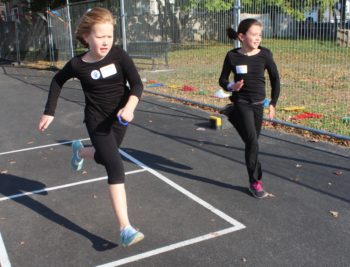Photo: What a new press box will look like in the fall of 2017.
In less than a week, Belmont’s most prominent business has scored big with the town’s high school athletic program.
On Monday, Nov. 7, the Belmont Savings Bank Foundation announced a $15,000 donation to complete the fundraising effort to build a new, state-of-the-art press box at Belmont High School’s Harris Field.
A week earlier, the foundation made a $7,500 matching donation that supported the annual fundraising effort of the Belmont Boosters, which this year yielded nearly $19,000.
“The Belmont Savings Bank Foundation’s matching gift is critical to the success of the Booster “B” Drive not only because of its significance in terms of sheer dollars, but also because it’s a major rallying point for the BHS parents and student-athletes who make it all happen,” said Booster’s President Larry Christofori.
Completing the Press Box
After nearly a decade during which the designated press area has been officially closed, it is now expected a rebuilt press box will be up and running by the opening of the 2017 fall and football season.
“We are more than happy to help make the press box for Belmont High School and its student athletes a reality.” said Hal Tovin, executive vice president and COO of Belmont Savings Bank and director of the Foundation.
“It will be a wonderful addition to Harris Field as well as the town of Belmont itself,” he said.
In 2002, Harris Field was rebuilt with an all-weather turf and track, seating and lighting. Initially, a press box was included in plans before funding fell short. Last year, a group of residents and Belmont High School athletic boosters created a Harris Field Building Committee with the goal of raising $240,000 to make the press box project a reality,
Belmont’s Town Meeting approved $165,000 for the project, leaving $75,000 to be raised by private sources. With the help of private organizations, individual donors, and groups that support Belmont sports teams, the town was able to raise much of those private funds with Belmont Savings put the program over the top with the last $15,000 donation.
With the addition of the press box, both the school and the community will procure multiple benefits as students will see improved game coaching and film capabilities for instruction between games and employees and volunteers who staff events at Harris Field will have a more comfortable experience.
Boosters find the funds
While the press box will be used by coaches and the media, the money raised each year by the parents run Belmont Boosters provides revenue for items unfunded by the Belmont High School Athletic Department budget through individual grant requests, the purchase of varsity letterman’s jackets and investing in capital equipment and facilities.
Previously the Boosters funded the renovation of the White Field House and the school’s Fitness Center and the laying of a new floor/court at the Wenner Field House.
In late October, the student-athletes were divided into teams and followed a route in Belmont to solicit contributions through door-to-door engagement with the community. In exchange for a donation of $20, supporters received a Belmont “B” which can be displayed in a window in support of the school athletic program.
“We are more than happy to match the efforts of our student-athletes, who work so hard alongside the Booster parent volunteers to ensure their programs are properly funded,” said Tovin.
The mission of the Belmont Savings Bank Foundation is to provide financial support to organizations in the communities served by Belmont Savings Bank, particularly those committed towards education, health and human services, youth programs, and affordable housing.































































